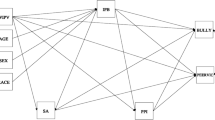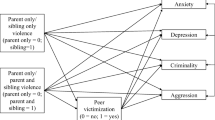Abstract
Using data from a diverse sample of 581 families living in predominantly low-income, rural communities, the current study sought to investigate the longitudinal associations among father-perpetrated intimate partner violence (IPV) and child-directed physical aggression perpetrated by the mother. The unique contributions of each of these types of family violence on children’s behavioral problems at school entry were also examined. Results confirm bidirectional associations between father-perpetrated IPV and maternal physical aggression directed toward the child, and indicate that both types of physical aggression contribute to child behavior problems at school entry.

Similar content being viewed by others
Notes
In posthoc analyses, we investigated whether the sex of the child moderated any of the relations presented in the current study. Results from moderation analyses as well as from two group analyses (where separate models were estimated for boys and girls) revealed no such differences.
Although the focus of the current study was on maternal child-directed physical aggression and father-perpetrated IPV (for the reasons outlined on page 8), during supplemental analyses we also investigated the role of mother-perpetrated IPV and father-perpetrated child-directed physical aggression in this model. Specifically, bidirectional paths between all four types of family violence were estimated, in addition to direct paths from all four types of family violence to the children’s behavioral problem latent variable. Contrary to expectation, when considered in a model with father-perpetrated IPV and mother-perpetrated child-directed physical aggression, we found that (in this sample, at this child age, and with this child outcome) these other two types of family violence were not related to any of the variables presented in the current manuscript. We suspect that these lack of findings are likely due to multicollinearity among the different types of family violence, however future research should more fully explore this suggestion.
References
Anderson, K. L. (2010). Conflict, power, and violence in families. Journal of Marriage and Family, 72(3), 726–742. doi:10.1111/j.1741-3737.2010.00727.x.
Appel, A. E., & Holden, G. W. (1998). The co-occurrence of spouse and physical child abuse: a review and appraisal. Journal of Family Psychology, 12(4), 578–599. doi:10.1037//0893-3200.12.4.578.
Arbuckle, J. L. (1996). Full information estimation in the presence of incomplete data. In G. A. Marcoulides & R. E. Schumacker (Eds.), Advanced structural equation modeling (pp. 243–277). Mahwah: Erlbaum.
Baumrind, D. (1993). The average expectable environment is not good enough: a response to Scarr. Child Development, 64(5), 1299–1317. doi:10.2307/1131536.
Bentler, P. M. (1990). Comparative fit indexes in structural models. Psychological Bulletin, 107(2), 238–246. doi:10.1037/0033-2909.107.2.238.
Berlin, L. J., Ispa, J. M., Fine, M. A., Malone, P. S., Brooks-Gunn, J., Brady-Smith, C., Ayoub, C., & Bai, Y. (2009). Correlates and consequences of spanking and verbal punishment for low-income white, African American, and Mexican American toddlers. Child Development, 80(5), 1403–1420. doi:10.1111/j.1467-8624.2009.01341.x.
Browne, M. W., & Cudeck, R. (1993). Alternative ways of assessing model fit. In K. A. Bollen & J. S. Long (Eds.), Testing structural equation models (pp. 136–162). Newbury Park: Sage.
Burchinal, M., Vernon-Feagans, L., Cox, M., & the Family Life Project Investigators. (2008). Cumulative social risk, parenting, and infant development in rural low-income communities. Parenting: Science and Practice, 8(1), 41–69. doi:10.1080/15295190701830672.
Campbell, S. B. (1995). Behavior problems in preschool children: a review of recent research. Journal of Child Psychology and Psychiatry & Allied Disciplines, 36(1), 113–149. doi:10.1111/j.1469-7610.1995.tb01657.x.
Cox, M. J., & Paley, B. (1997). Families as systems. Annual Review of Psychology, 48(1), 243–267. doi:10.1146/annurev.psych.48.1.243.
Cox, M. J., & Paley, B. (2003). Understanding families as systems. Current Directions in Psychological Science, 12(5), 193–196. doi:10.1111/1467-8721.01259.
Cummings, E. M., & Davies, P. T. (2010). Marital conflict and children: an emotional security perspective. New York: Guilford Press.
Edleson, J. (1999). Children’s witnessing of adult domestic violence. Journal of Interpersonal Violence, 14(8), 839–870. doi:10.1177/088626099014008004.
Fantuzzo, J., & Fusco, R. (2007). Children’s direct exposure to types of domestic violence crime: a population-based investigation. Journal of Family Violence, 22(7), 543–552. doi:10.1007/s10896-007-9105-z.
Gershoff, E. T. (2002). Corporal punishment by parents and associated child behaviors and experiences: a meta-analytic and theoretical review. Psychological Bulletin, 128(4), 539–579. doi:10.1037//0033-2909.128.4.539.
Goodman, R. (2001). Psychometric properties of the Strengths and Difficulties Questionnaire. Journal of the American Academy of Child and Adolescent Psychiatry, 40(11), 1337–1345. doi:10.1097/00004583-200111000-00015.
Hinshaw, S. P., Han, S. S., Erhardt, D., & Huber, A. (1992). Internalizing and externalizing behavior problems in preschool children: correspondence among parent and teacher ratings and behavior problems. Journal of Clinical Child Psychology, 21(2), 143–150. doi:10.1207/s15374424jccp2102_6.
Hofferth, S. L., Stueve, J. L., Pleck, J., Bianchi, S., & Sayer, L. (2002). The demography of fathers: what fathers do. In C. S. Tamis-LeMonda & N. Cabrera (Eds.), Handbook of father involvement: multidisciplinary perspectives (pp. 63–90). Mahwah: Erlbaum.
Holt, S., Buckley, H., & Whelen, S. (2008). The impact of exposure to domestic violence on children and young people: a review of the literature. Child Abuse & Neglect, 32(8), 797–810. doi:10.1016/j.chiabu.2008.02.004.
Huang, C.-C., Wang, L.-R., & Warrener, C. (2010). Effects of domestic violence on behavior problems of preschool-aged children: do maternal mental health and parenting mediate the effects? Children and Youth Services Review, 32(10), 1317–1323. doi:10.1016/j.childyouth.2010.04.024.
Jaffee, S. R., Moffitt, T. E., Caspi, A., Taylor, A., & Arsenault, L. (2002). Influence of adult domestic violence on children’s internalizing and externalizing problems: an environmentally informative twin study. Journal of the American Academy of Child and Adolescent Psychiatry, 41(9), 1095–1103. doi:10.1097/00004583-200209000-00010.
Jouriles, E. N., McDonald, E., Smith Slep, A. M., Heyman, R. E., & Garrido, E. (2008). Child abuse in the context of domestic violence: prevalence, explanations, and practice implications. Violence and Victims, 23(2), 221–235. doi:10.1891/0886-6708.23.2.221.
Keiley, M. K., Howe, T. R., Dodge, K. A., Bates, J. E., & Pettit, G. S. (2001). The timing of child physical maltreatment: a cross-domain growth analysis of impact on adolescent externalizing and internalizing problems. Developmental Psychopathology, 13(4), 891–912.
Kitzmann, K. M., Gaylord, N. K., Holt, A. R., & Kenny, E. D. (2003). Child witnesses to domestic physical violence: a meta-analytic review. Journal of Consulting and Clinical Psychology, 71(2), 339–352. doi:10.1037/0022-006x.71.2.339.
Knickerbocker, L., Heyman, R. E., Slep, A. M. S., Jouriles, E. N., & McDonald, R. (2007). Co-occurrence of child and partner maltreatment: definitions, prevalence, theory, and implications for assessment. European Psychologist, 12(1), 36–44. doi:10.1027/1016-9040.12.1.36.
Krishnakumar, A., & Buehler, C. (2000). Inter-parental conflict and parenting behaviors: a meta-analytic review. Family Relations, 49(1), 25–44. doi:10.1111/j.1741-3729.2000.00025.x.
Levendosky, A. A., & Graham-Bermann, S. A. (2001). Parenting in battered women: the effects of domestic violence on women and their children. Journal of Family Violence, 16(2), 171–192. doi:10.1023/A:1011111003373.
Levendosky, A. A., Huth-Bocks, A. C., Shapiro, D. L., & Semel, M. A. (2003). The impact of domestic violence on the maternal-child relationship and preschool-age children’s functioning. Journal of Family Psychology, 17(3), 275–287. doi:10.1037/0893-3200.17.3.275.
Levendosky, A. A., Leahy, K. L., Bogat, A., Davidson, W. S., & von Eye, A. (2006). Domestic violence, maternal parenting, maternal mental health, and infant externalizing behavior. Journal of Family Psychology, 20(4), 544–552. doi:10.1037/0893-3200.20.4.544.
Levendosky, A. A., Bogat, G. A., & von Eye, A. (2007). New directions for research on intimate partner violence and children. European Psychologist, 12(1), 1–5. doi:10.1027/1016-9040.12.1.1.
Litrownick, A. J., Newton, R., Hunter, W. H., English, D., & Everson, M. D. (2003). Exposure to family violence in young at-risk children: a longitudinal look at the effects of victimization and witnessed physical and psychological aggression. Journal of Family Violence, 18(1), 59–73. doi:10.1023/A:1021405515323.
Maccoby, E., & Martin, M. (1983). Socialization in the context of the family: parent-child interaction. In P. Mussen (Ed.), Handbook of child psychology (Vol. 4, pp. 1–101). New York: Wiley.
McDonald, R., Jouriles, E. N., Ramisetty-Mikler, S., Caetano, R., & Green, C. E. (2006). Estimating the number of children living in partner-violent families. Journal of Family Psychology, 20(1), 137–142. doi:10.1037/0893-3200.20.1.137.
McLoyd, V. C., & Smith, J. (2002). Physical discipline and behavior problems in African American, European American and Hispanic children: Emotional support as a moderator. Journal of Marriage and Family, 64(1), 40–53. doi:10.1111/j.1741-3737.2002.00040.x.
Muthén, L. K., & Muthén, B. O. (1998–2010). Mplus user’s guide (6th ed.). Los Angeles: Muthén & Muthén.
Pleck, J. H., & Masciadrelli, B. P. (2004). Paternal involvement by U.S. residential fathers: Levels, sources, and consequences. In M. E. Lamb (Ed.), The role of the father in child development (4th ed., pp. 222–271). New York: Wiley.
Rimm-Kaufman, S. E., Pianta, R., & Cox, M. (2000). Teachers’ judgments of problems in the transition to kindergarten. Early Childhood Research Quarterly, 15(2), 147–166. doi:10.1016/s0885-2006(00)00049-1.
Slep, A. S., & O’Leary, S. G. (2001). Examining partner and child abuse: are we ready for a more integrated approach to family violence? Clinical Child and Family Psychology Review, 4(2), 87–107. doi:10.1023/A:1011319213874.
Sternberg, K. J., Lamb, M. E., Greenbaum, C., Cicchetti, D., Dawud, S., Cortes, R. M., Krispin, O., & Lorey, F. (1993). Effects of domestic violence on children’s behavior problems and depression. Developmental Psychology, 29(1), 444–452. doi:10.1037//0012-1649.29.1.44.
Stets, J., & Straus, M. (1989). The marriage license as a hitting license: a comparison of assaults in dating, cohabiting, and married couples. Journal of Family Violence, 4(2), 161–180. doi:10.1007/BF01006627.
Straus, M. (1979). Measuring intrafamily conflict and violence: the conflict tactics scales. Journal of Marriage and the Family, 41(1), 75–88. doi:10.2307/351733.
Straus, M. A., & Gelles, R. J. (1990). Physical violence in American families: risk factors and adaptations to violence in 8,145 families. New Bruswick: Transaction.
Straus, M. A., & Stewart, J. H. (1999). Corporal punishment by American parents: national data on prevalence, chronicity, severity, and duration, in relation to child and family characteristics. Clinical Child and Family Psychology Review, 2(2), 55–70. doi:10.1023/A:1021891529770.
Straus, M., & Sweet, S. (1992). Verbal/symbolic aggression in couples: incidence rates and relationships to personal characteristics. Journal of Marriage and the Family, 54(2), 346–357. doi:10.2307/353066.
Tolan, P., Gorman-Smith, D., & Henry, D. (2006). Family violence. Annual Review of Psychology, 57(1), 557–583. doi:10.1146/annurev.psych.57.102904.190110.
Tucker, L. R., & Lewis, C. (1973). A reliability coefficient for maximum likelihood factor analysis. Psychometrika, 38(1), 1–10. doi:10.1007/bf02291170.
Wolfe, D. A., Crooks, C. V., Lee, V., McIntyre-Smith, A., & Jaffe, P. G. (2003). The effects of children’s exposure to domestic violence: a meta-analysis and critique. Clinical Child and Family Psychology Review, 6(3), 171–187. doi:10.1023/A:1024910416164.
Acknowledgments
This research was supported by a grant from the National Institute of Child Health and Human Development (PO1-HD-39667), with co-funding from the National Institute on Drug Abuse.
Author information
Authors and Affiliations
Consortia
Corresponding author
Rights and permissions
About this article
Cite this article
Gustafsson, H.C., Barnett, M.A., Towe-Goodman, N.R. et al. Family Violence and Children’s Behavior Problems: Independent Contributions of Intimate Partner and Child-Directed Physical Aggression. J Fam Viol 29, 773–781 (2014). https://doi.org/10.1007/s10896-014-9628-z
Published:
Issue Date:
DOI: https://doi.org/10.1007/s10896-014-9628-z




